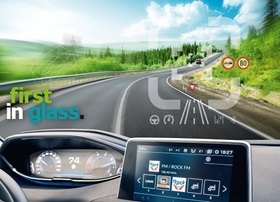Today I want to cover an exciting topic: Head-Up-Displays (HUD). I’ll talk about their functions and setting options after a windscreen replacement.
Various automotive manufacturers like Audi, BMW, Mercedes, Volkswagen, and others equip their vehicles with HUD. Using this, important information is directly displayed in the driver’s field of vision while driving. This helps increase attention on the traffic ahead as the driver doesn’t need to switch focus between the road, speedometer, navigation system and various other information or entertainment systems.

But how does that work in detail?
Let’s start by looking at the structure of a windscreen. Every windscreen is made of laminated safety glass consisting of two glasses and a PVB-foil in between. These PVB-foils can fulfil various additional functions such as reducing noise, controlling heat in summer, adding heating wires to defrost windscreens in the winter or integrating antennas.
But HUD windscreens contain a special feature: The PVB-foil has a wedge shape compared to conventional PVB-foils. This enables a sharp projection and a clear and easy-to-read image for the driver. Two parallel glass surfaces would lead to a double image (also known as “ghosting”) in a HUD windscreen.
Why is my HUD image distorted?
After replacing the windscreen, the projection can be displayed sharply, but may still appear distorted, twisted, crooked, or stretched. This is often assumed to be a defect in the windscreen, but the reason for this may be a change in the installation. Don’t worry – it can normally be adjusted with the workshop software.
Fine-tuning - how does it work?
Here are a few tips and tricks for you:
- For VAG vehicles, the HUD setting can be adjusted using the OE software and a special target.
- The same can be used for BMW, but not E60/61. For E60/61, the HUD is adjusted via an eccentric shaft behind the navigation display.
- For Mercedes the corresponding settings can be also adjusted with the help of the OE workshop software.
- The HUD settings for height and rotation can already be made in many vehicles via the workshop menu itself.
- If you don’t have access to the original software, it’s best to obtain OE access for a fee or work with a partner. Our ReCO™ team is also available to help and advise you.
Extra tip - Brightness
Did you know that the rain light sensor affects the brightness of the HUD projection? This means that if the sensor is damaged, incorrectly mounted or adjusted, the HUD image can be completely dimmed and hard to read during the day. So, after replacing the windscreen, the rain sensor should also be initialised (see chapter 6).
What does it mean for you?
Take a close look at the HUD projection after replacing the windscreen and check which settings for height, rotation, and brightness (keyword: rain light sensor) have to be made. If you have any questions, our ReCO™ team will be very happy to help.
I’m excited about the future and the latest trend towards AR (short for Augmented Reality), using major parts of the windscreen as a projection surface.